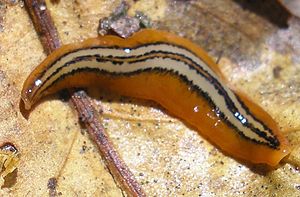Cratera
| Cratera | ||||||||||||
|---|---|---|---|---|---|---|---|---|---|---|---|---|

Cratera pseudovaginuloides, dorsale Ansicht, Vorderende links | ||||||||||||
| Systematik | ||||||||||||
| ||||||||||||
| Wissenschaftlicher Name | ||||||||||||
| Cratera | ||||||||||||
| Carbayo et al., 2013 |
Cratera ist eine räuberisch lebende Gattung der Landplanarien, die in Südamerika beheimatet ist.
Merkmale

Charakteristisch für die Gattung Cratera ist der blattförmige Körper. Die meisten Arten haben eine Länge zwischen 3 und 7 cm. Sie besitzen hunderte Augen, die entlang des Körpers verteilt sind. Die einfach gelappten, kreisrunden Augen sind einfach aufgebaut. Das Kopulationsorgan besitzt einen konischen Penis, der die gesamte männliche Geschlechtshöhle ausfüllt. Der letzte Teil des Ejakulationskanals, durch den Spermien durch den Penis geleitet werden, hat eine ausgeweitete Höhle, die an einen Vulkankrater erinnert.[1]
Etymologie
Der Gattungsname Cratera leitet sich vom lateinischen Wort „crater“ ab. Der Name bezieht sich auf den Hohlraum im Penis, der einem Vulkankrater ähnelt.
Arten
Der Gattung Cratera werden folgende Arten zugeschrieben:
- Cratera anamariae Carbayo & Almeida, 2015[2]
- Cratera arucuia Lago-Barcia & Carbayo, 2018[3]
- Cratera assu Araujo, Carbayo, Riutort & Álvarez-Presas, 2020[4]
- Cratera aureomaculata Rossi & Leal-Zanchet, 2017[5]
- Cratera boja Araujo, Carbayo, Riutort & Álvarez-Presas, 2020[4]
- Cratera crioula (E. M. Froehlich, 1955)[1]
- Cratera cryptolineata Rossi & Leal-Zanchet, 2017[5]
- Cratera cuarassu Carbayo & Almeida, 2015[2]
- Cratera hina (Marcus, 1951)[3]
- Cratera imbiri Araujo, Carbayo, Riutort & Álvarez-Presas, 2020[4]
- Cratera joia (Froehlich, 1956)[1]
- Cratera nigrimarginata Rossi & Leal-Zanchet, 2017[5]
- Cratera ochra Rossi, Amaral, Ribeiro, Cauduro, Fick, Valiati & Leal-Zanchet, 2015[6]
- Cratera obsidiana Amaral, Boll & Leal-Zanchet, 2019[7]
- Cratera paraitinga Araujo, Carbayo, Riutort & Álvarez-Presas, 2020[4]
- Cratera picuia Lago-Barcia & Carbayo, 2018[3]
- Cratera pseudovaginuloides (Riester, 1938)[1]
- Cratera steffeni Rossi, Fontoura, Amaral & Leal-Zanchet, 2014[8]
- Cratera tamoia (E. M. Froehlich, 1955)[1]
- Cratera taxiarcha (Marcus, 1951)[3]
- Cratera tui Araujo, Carbayo, Riutort & Álvarez-Presas, 2020[4]
- Cratera viridimaculata Negrete & Brusa, 2016[9]
- Cratera yara (E. M. Froehlich, 1955)[1]
Systematik
Aufgrund molekulargenetischer Untersuchungen der Unterfamilie der Geoplaninae kam das Forschungsteam um Fernando Carbayo zu dem Ergebnis, dass die Gattung Geoplana, die ursprünglich mehr als hundert Arten umfasste, polyphyletisch war. Eine der durch diese Ergebnisse neu abgegrenzten Gattungen ist Cratera.[1]
Das Schwestertaxon von Cratera ist gemäß der Untersuchungen die Gattung Obama, welche ein sehr ähnliches Erscheinungsbild hat, jedoch neben einfach gelappten auch dreifach gelappte Augen hat.[1][6]
Weblinks
Einzelnachweise
- ↑ a b c d e f g h F. Carbayo, M. Álvarez-Presas, C. U. T. Olivares, F. P. L. Marques, E. X. M. Froehlich, M. Riutort: Molecular phylogeny of Geoplaninae (Platyhelminthes) challenges current classification: Proposal of taxonomic actions. In: Zoologica Scripta. 42, Nr. 5, 2013, S. 508–528. doi:10.1111/zsc.12019.
- ↑ a b Fernando Carbayo, Ana Laura Almeida: Anatomical deviation of male organs of land planarians from Rio de Janeiro, Brazil, with description of two new species of Cratera (Platyhelminthes, Tricladida). In: Zootaxa. 3931, Nr. 1, 2015, ISSN 1175-5334, S. 27–40. doi:10.11646/zootaxa.3931.1.2. PMID 25781812.
- ↑ a b c d Domingo Lago-Barcia, Fernando Carbayo: Taxonomic revision of four species of the Neotropical land planarian genera Cratera and Geoplana (Platyhelminthes, Tricladida) with a description of two new species and an emendation of Cratera. In: Zootaxa. 4500, Nr. 4, 2018, ISSN 1175-5334, S. 517–542. doi:10.11646/zootaxa.4500.4.3. PMID 30486048.
- ↑ a b c d e Ana Paula Goulart Araujo, Fernando Carbayo, Marta Riutort & Marta Álvarez-Presas: Five new pseudocryptic land planarian species of Cratera (Platyhelminthes: Tricladida) unveiled through integrative taxonomy. In: PeerJ. Band 8, 2020, S. e9726, doi:10.7717/peerj.9726.
- ↑ a b c Ilana Rossi, Ana Leal-Zanchet: Three new species of Cratera Carbayo et al., 2013 from Araucaria forests with a key to species of the genus (Platyhelminthes, Continenticola). In: ZooKeys. Nr. 643, 2017, ISSN 1313-2970, S. 1–32. doi:10.3897/zookeys.643.11093. PMID 28144173. PMC 5242264 (freier Volltext).
- ↑ a b Ilana Rossi, Silvana Vargas Amaral, Giovana Gamino Ribeiro, Guilherme Pinto Cauduro, Israel Fick, Victor Hugo Valiati, Ana Maria Leal-Zanchet: Two new Geoplaninae species (Platyhelminthes: Continenticola) from Southern Brazil based on an integrative taxonomic approach. In: Journal of Natural History. 50, Nr. 13–14, 2015, ISSN 0022-2933, S. 787–815. doi:10.1080/00222933.2015.1084057.
- ↑ Piter Kehoma Boll, Silvana Vargas Amaral, Ana Maria Leal-Zanchet: Two new land planarian species (Platyhelminthes: Tricladida: Geoplanidae) from protected areas in southern Brazil. In: Zootaxa. 4664, Nr. 4, 2019, ISSN 1175-5334, S. 535–550. doi:10.11646/zootaxa.4664.4.5. PMID 31716655.
- ↑ Ilana Rossi, Marcela Fontoura, Silvana Amaral, Ana M. Leal-Zanchet: A new species of land flatworm (Platyhelminthes: Continenticola) from areas of Araucaria> Forest in southern Brazil. In: Zootaxa. 3794, Nr. 4, 2014, ISSN 1175-5334, S. 514–524. doi:10.11646/zootaxa.3794.4.2. PMID 24870339.
- ↑ Lisandro Negrete, Francisco Brusa: First report of the genus Cratera (Platyhelminthes, Geoplanidae) in Argentina, with description of a new species and comments on the species of the genus. In: ZooKeys. Nr. 610, 2016, ISSN 1313-2970, S. 1–12. doi:10.3897/zookeys.610.9465. PMID 27587974. PMC 4992809 (freier Volltext).